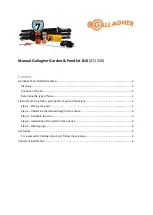
Safety
Yamatake Corporation
vi
Model HGC303 - Heat Value Gas Chromatograph
1. Class I, Division 1 locations
1.1
Wiring methods
•
Threaded rigid metal conduit, threaded steel intermediate metal conduit, or
Type MI cable with termination fittings approved for the location
, can be
employed
•
Threaded joints
must be made up with at least five threads fully engaged.
• Boxes, fittings, and joints must be approved for Class I, Division 1.
1.2
Sealing
• Each conduit entering the apparatus enclosure is required to be sealed
within 18 in. (457 mm) from the enclosure.
• The sealing of each conduit can be provided with
a sealing fitting approved for
class I locations.
•
Sealing compound must be approved
and must not have a melting point of less
than 93° (200°F).
• The minimum thickness of the sealing compound should not be less than the
trade size of the conduit and, in no case, less than 5/8 in.(16 mm).
• Splices and taps cannot be made in the fittings.
2. Class I, Division 2 locations
2.1
Wiring methods
•
Threaded rigid metal conduit, threaded steel intermediate metal conduit,
enclosed gasketed busways
, or
Type PLTC cable
in accordance with the
provisions of remote-control, signaling, and power-limited circuits (see NEC,
Article 725), or
Type ITC cable
in cable trays, in raceways, supported by
messenger wire, or directly buried where the cable is listed for this use;
Type
MI, MC, MV, or TC cable with approved termination fittings
can be
employed.
• Boxes, fittings, and joints are not required to be explosionproof.
2.2
Sealing
• Each conduit entering the apparatus enclosure is required to be sealed as shown in 1.2.
3. Class II, Division 1 locations
3.1
Wiring methods
•
Threaded rigid metal conduit, threaded steel intermediate metal conduit, or
Type MI cable with termination fittings approved for the location
, can be
employed.
• Boxes and fittings must be dusttight.
3.2
Sealing
• Where
a raceway
provides communication between the apparatus enclosure and
an enclosure that is not required to be dust-ignitionproof, suitable means must be
provided to prevent the entrance of dust into the dust-ignitionproof enclosure
through the raceway. One of the following means can be used: (1) a permanent
and effective seal; (2) a horizontal raceway not less than 10 ft (3.05 m) long; or
(3) a vertical raceway not less than 5 ft (1.52 m) long and extending downward
from the dust-ignitionproof enclosure.
• Seals are not required to be explosionproof.
Summary of Contents for HGC303
Page 10: ...Safety Yamatake Corporation viii Model HGC303 Heat Value Gas Chromatograph ...
Page 42: ...Installation Yamatake Corporation 2 22 Model HGC303 Heat Value Gas Chromatograph ...
Page 110: ...Operation Yamatake Corporation 3 68 Model HGC303 Heat Value Gas Chromatograph ...
Page 112: ...Maintenance Yamatake Corporation 4 2 Model HGC303 Heat Value Gas Chromatograph ...
Page 127: ...Yamatake Corporation Appendix Model HGC303 Heat Value Gas Chromatograph A 13 Drawings HGC00 ...
Page 128: ...Appendix Yamatake Corporation A 14 Model HGC303 Heat Value Gas Chromatograph ...









































